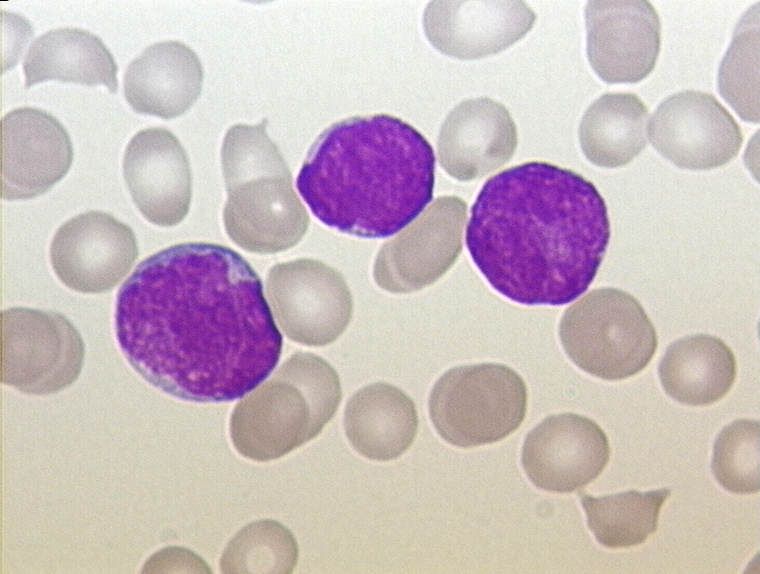
FDA Approves Blinatumomab in CD19+ Ph– B-Cell ALL

Phase 3 data from the E1910 trial support the FDA approval of blinatumomab in CD19-positive Philadelphia chromosome–negative B-cell precursor ALL.
The News
The FDA has granted approval to blinatumomab (Blincyto) as a treatment for adult and pediatric patients 1 month or older with CD19-positive Philadelphia chromosome–negative B-cell precursor acute lymphoblastic leukemia (B-ALL), according to a press release from the agency.1
Supporting Data
The approval for blinatumomab in this indication was partly supported by findings from the phase 3 E1910 study (NCT02003222) and the phase 3 20120215 trial (NCT02393859).2,3
In the E1910 study, the 3-year overall survival (OS) rates were 84.8% (95% CI, 76.3%-90.4%) in the blinatumomab arm and 69% (95% CI, 58.7%-77.2%) in the chemotherapy arm (HR, 0.42; 95% CI, 0.24-0.75; P = .003). At 5 years, the OS rates were 82.4% (95% CI, 73.7%-88.4%) vs 62.5% (95% CI, 52.0%-71.3%; HR, 0.44; 95% CI, 0.25-0.76).
Additional findings from the
In patients who were MRD negative and younger than 55 years old, the median OS was not reached with the blinatumomab combination vs not reached with chemotherapy only (HR, 0.18; 95% CI, 0.06-0.52; P <.001). Among those with MRD negativity who were older than 55 years, the median OS was not reached vs 71.4 months in each respective arm (HR, 0.77; 95% CI, 0.37-1.58; P = .47). For those with undetectable MRD at the time of randomization, the median OS was not reached in either arm (HR, 0.51; 95% CI, 0.27-0.97; P = .038).
In the 20120215 study, the 5-year OS rates were 78.4% (95% CI, 64.2%-87.4%) in the blinatumomab arm vs 41.4% (95% CI, 26.3%-55.9%) in the chemotherapy arm (HR, 0.35; 95% CI, 0.17-0.70). The 5-year relapse-free survival rate was 61.1% (95% CI, 46.3%-72.9%) in the blinatumomab arm and 27.6% (95% CI, 16.2%-40.3%) in the chemotherapy arm (HR, 0.38; 95% CI, 0.22-0.66).
Expert Perspective
“At a median follow-up of approximately 3 and a half years, OS was statistically significantly better in the patients who received blinatumomab. This is a critically important development,” Colin A. Vale, MD, said in an interview with CancerNetwork® regarding the data from the E1910 study. “Despite high initial rates of remission following induction chemotherapy, relapses are unfortunately common [following] our standard consolidation and maintenance approaches. This represents an unmet need in terms of further reducing relapse risk in this patient population.”
Vale is an assistant professor of Hematology and Medical Oncology at Emory University School of Medicine.
E1910 Study Design
In this trial, patients were assigned to receive chemotherapy with or without blinatumomab. After induction chemotherapy, patients received 4 additional cycles of consolidation chemotherapy or 2 cycles of blinatumomab for 28 days of each cycle.4 Following completion of consolidation chemotherapy with or without blinatumomab, patients received 6-mercaptopurine plus vincristine, methotrexate, and prednisone (POMP) maintenance therapy for 2.5 years.
The trial’s primary end point was OS.5 Secondary end points included relapse-free survival, MRD status, and adverse effects.
Patients 30 to 70 years old with newly diagnosed B lineage ALL confirmed via bone marrow or peripheral blood immunophenotyping and negativity for the Philadelphia chromosome were eligible for enrollment on the trial. Additional eligibility criteria included having no recent history of myocardial infarction and an ECOG performance status of 0 to 3.
The
The
Additional 20120215 Data
This trial assessed pediatric and adult patients who received the aforementioned regimen. Patients were randomly assigned to receive blinatumomab or IntReALLHR2010 HC3 intensive combination chemotherapy during the third consolidation cycle.
Those enrolled were stratified by age, MRD status at the end of induction, and bone marrow status at the end of the second block of consolidation therapy. Overall, 54 patients were enrolled in the blinatumomab arm compared with 57 in the chemotherapy arm.
References
- FDA approved blinatumomab as consolidation for CD19-positive Philadelphia chromosome-negative B-cell precursor acute lymphoblastic leukemia. News release. FDA. June 14, 2024. Accessed June 14, 2024. https://shorturl.at/o5BTQ
- Litzow M, Sun Z, Mattison R, et al. S115: Consolidation with blinatumomab improves overall and relapse-free survival in patients with newly diagnosed B-cell acute lymphoblastic leukemia: impact of age and MRD level in ECOG-ACRIN E1910. Hemasphere. 2023;7(suppl):e1944062. doi:10.1097/01.HS9.0000967372.19440.62.
- Locatelli F, Zugmaier G, Rizzari C, et al. Effect of blinatumomab vs chemotherapy on event-free survival among children with high-risk first-relapse B-cell acute lymphoblastic leukemia: a randomized clinical trial. JAMA. 2021;325(9):843-854. doi:10.1001/jama.2021.0987
- Litzow MR, Sun Z, Paietta E, et al. Consolidation therapy with blinatumomab improves overall survival in newly diagnosed adult patients with B-lineage acute lymphoblastic leukemia in measurable residual disease negative remission: results from the ECOG-ACRIN E1910 randomized phase III National Cooperative Clinical Trials Network trial. Blood. 2022;140(suppl 2):LBA-1. doi:10.1182/blood-2022-171751
- Combination chemotherapy with or without blinatumomab in treating patients with newly diagnosed BCR-ABL-negative B lineage acute lymphoblastic leukemia. ClinicalTrials.gov. Accessed May 2, 2024. https://tinyurl.com/mwysvnrn
- Amgen reports fourth quarter and full year 2023 financial results. News release. Amgen. February 6, 2024. Accessed May 2, 2024. http://tinyurl.com/2ts33adj
- FDA grants full approval for Blincyto (blinatumomab) to treat minimal residual disease-positive B-cell precursor acute lymphoblastic leukemia. News release. Amgen. June 21, 2023. Accessed June 21, 2023. https://bit.ly/3XjCsbG
Newsletter
Stay up to date on recent advances in the multidisciplinary approach to cancer.































































































